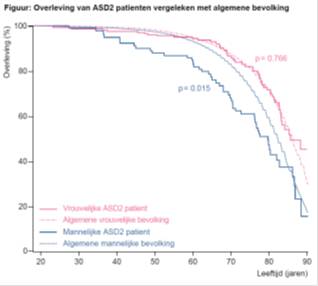ASDII: sex differences in prognosis

For acquired heart disease, such as coronary artery disease, differences in presentation and prognosis between the sexes are well-known. Little is known, however, about the existence of such sex-differences among patient with congenital heart disease.
Using the large Dutch nationwide registry for adults with congenital heart disease, CONCOR, we compared the survival of men and women with a type 2 atrial septal defect (ASD2) to that of the general Dutch population. We further assessed the disease burden of these patients during adult life.
The mean life-expectancy was 85.6 years for women, 79.7 years for men with an ASD2. As is seen in the figure, life-expectancy is normal for women with an ASD2, but somewhat reduced for men, when compared to the general Dutch population. The disease burden, predominantly in the form of rhythm disturbances and heart failure, was found to be increased in both men and women with an ASD2. Disease burden was also higher among men.
These results emphasize that it is important for adults with an ASD2 to remain under medical surveillance of a cardiologist, in order to timely and adequately detect and treat complications. The greater burden of disease in men, along with their reduced life-expectancy, also emphasize that prognosis could be improved with good medical surveillance and timely treatment.
Drs. J.M. Kuypers, research fellow



